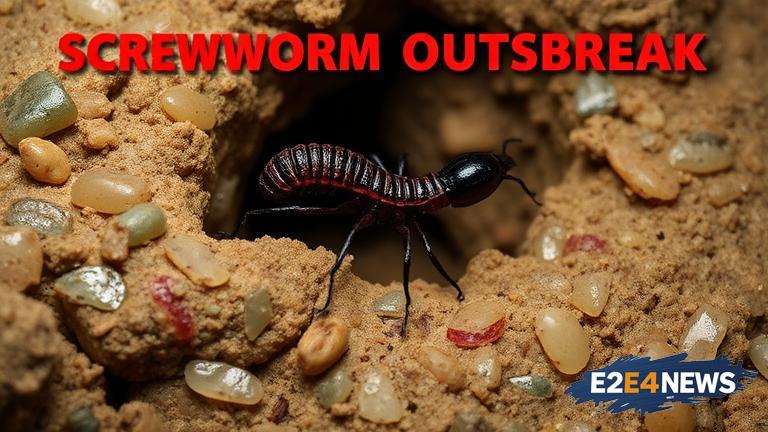The New World screwworm, also known as Cochliomyia hominivorax, is a parasitic insect that has been found in the southern United States. This invasive species is known to infest livestock, particularly cattle, sheep, and goats, as well as wildlife, including deer and other mammals. The screwworm larvae feed on the flesh of their hosts, causing significant damage and potentially leading to death. The New World screwworm is native to the Americas, but it was eradicated from the US in the 1960s through a concerted effort by the US Department of Agriculture. However, recent outbreaks in Florida and Texas have raised concerns about the potential for the screwworm to re-establish itself in the country. The screwworm is typically spread through the movement of infested animals, as well as through contaminated equipment and vehicles. Farmers and ranchers are being advised to take precautions to prevent the spread of the screwworm, including inspecting their animals regularly and reporting any suspicious lesions or wounds. The US Department of Agriculture has also established a surveillance program to monitor for the presence of the screwworm. In addition to the threat to livestock, the New World screwworm also poses a risk to human health, as the larvae can infest humans and cause significant tissue damage. The screwworm is typically treated with insecticides and other medications, but prevention is key to controlling the spread of the disease. The economic implications of a screwworm outbreak could be significant, particularly for the livestock industry. The US is working with international partners to prevent the spread of the screwworm and to develop strategies for controlling the disease. Researchers are also working to develop new technologies and methods for detecting and treating screwworm infestations. The New World screwworm is a significant threat to animal health and welfare, and it is essential that farmers, ranchers, and animal owners take precautions to prevent the spread of the disease. The US Department of Agriculture is working to educate the public about the risks associated with the screwworm and to provide guidance on how to prevent and control the disease. In addition to the US, other countries in the Americas are also at risk for screwworm outbreaks, and international cooperation is essential for controlling the spread of the disease. The New World screwworm is a parasitic insect that requires a host to complete its life cycle, and it is typically found in warm and humid climates. The screwworm larvae can survive for several weeks without a host, and they can be spread through contaminated soil, water, and other materials. The US Department of Agriculture is working to develop strategies for controlling the screwworm, including the use of insecticides, biological control methods, and other techniques. The screwworm is a significant threat to animal health and welfare, and it is essential that farmers, ranchers, and animal owners take precautions to prevent the spread of the disease. The economic implications of a screwworm outbreak could be significant, particularly for the livestock industry. The US is working with international partners to prevent the spread of the screwworm and to develop strategies for controlling the disease. Researchers are also working to develop new technologies and methods for detecting and treating screwworm infestations. The New World screwworm is a significant threat to animal health and welfare, and it is essential that farmers, ranchers, and animal owners take precautions to prevent the spread of the disease. The US Department of Agriculture is working to educate the public about the risks associated with the screwworm and to provide guidance on how to prevent and control the disease.
